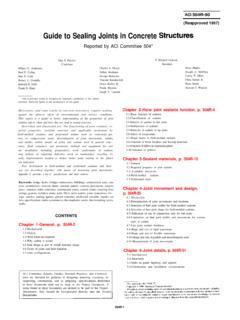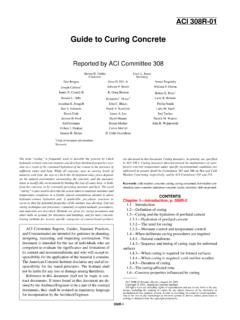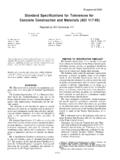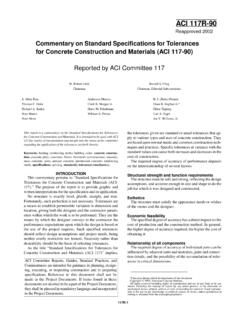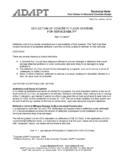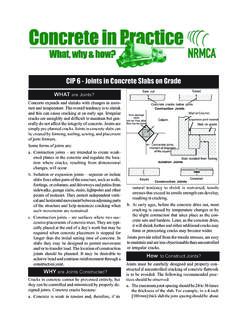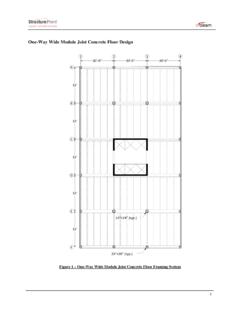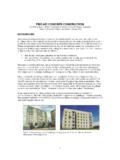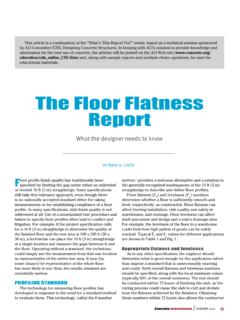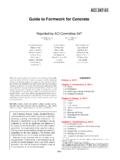Transcription of 302.1R-96 Guide for Concrete Floor and Slab Construction
1 Quality of a Concrete Floor or slab is highly dependent on achieving ahard and durable surface that is flat, relatively free of cracks, and at theproper grade and elevation. Properties of the surface are determined by themixture proportions and the quality of the concreting and jointing opera-tions. The timing of concreting operations especially finishing and joint-ing is critical. Failure to address this issue can contribute to undesirablecharacteristics in the wearing surface such as cracking, low resistance towear, dusting, scaling, high or low spots, and poor drainage, as well asincreasing the potential for Floor slabs employing portland cement, regardless of slump, willstart to experience a reduction in volume as soon as they are placed.
2 Thisphenomenon will continue as long as any water or heat, or both, is beingreleased to the surroundings. Moreover, since the drying and cooling ratesat the top and bottom of the slab will never be the same, the shrinkage willvary throughout the depth, causing the as-cast shape to be distorted, aswell as reduced in Guide contains recommendations for controlling random cracking andedge curling caused by the Concrete s normal volume change. Applicationof present technology permits only a reduction in cracking and curling, nottheir elimination. Even with the best Floor designs and proper Construction ,it is unrealistic to expect completely crack-free and curl-free results.
3 Con-sequently, every owner should be advised by both the designer and con-tractor that it is completely normal to expect some amount of cracking andcurling on every project, and that such occurrence does not necessarilyreflect adversely on either the competence of the Floor s design or the qualityof its ,2 Refer to the latest edition of ACI 360 for a detaileddiscussion of shrinkage and curling in slabs on ground. Refer to the latestedition of ACI 224 for a detailed discussion of cracking in reinforced andnonreinforced Concrete Guide describes how to produce high quality Concrete slabs on groundand suspended floors for various classes of service.
4 It emphasizes suchaspects of Construction as site preparation, concreting materials, concretemixture proportions, concreting workmanship, joint Construction , loadtransfer across joints, form stripping procedures, and curing. Finishingmethods, flatness/levelness requirements, and measurements are thorough preconstruction meeting is critical to facilitate communicationamong key participants and to clearly establish expectations and proce-dures that will be employed during Construction . Adequate supervision andinspection are required for job operations, particularly those of finishing.
5 Keywords: admixtures; aggregates; Concrete Construction ; Concrete dura-bility; Concrete finishing (fresh Concrete ); Concrete slabs; consolidation;contract documents; cracking (fracturing); curing; curling; deflection; floortoppings; floors; forms; form stripping; heavy-duty floors; inspection;joints (junctions); mixture proportioning; placing; quality control; sitepreparation; slab -on-ground Construction ; slump tests; specifications; stan-dards; suspended 1 Introduction, p. Purpose and Work of other relevant committeesChapter 2 Classes of floors, p. Classification of floorsACI for Concrete Floor and slab ConstructionReported by ACI Committee 302 Carl BimelChairmanEldon TippingSecretaryRobert B.
6 AndersonEdward B. FinkelWilliam S. PhelanCharles M. AultBarry E. ForemanDennis W. PhillipsCharles M. AyersTerry J. FricksJohn W. RohrerKenneth L. BeaudoinEugene D. Hill, L. ScottMichael G. CallasJerry A. HollandNandu K. ShahAngelo E. ColasantiArthur W. McKinneyPeter C. TatnallGregory DobsonJohn P. MundayR. Gregory TaylorRobert A. EpifanoScott NiemitaloMiroslav F. VejvodaSamuel A. Face, IIIR obert W. NussmeierSam J. VitaleWilliam C. PanareseACI became effective October 22, 1996. This document supersedes 1997, American Concrete rights reserved including rights of reproduction and use in any form or by anymeans, including the making of copies by any photo process, or by electronic ormechanical device, printed, written, or oral, or recording for sound or visual reproduc-tion or for use in any knowledge or retrieval system or device, unless permission inwriting is obtained from the copyright Committee reports, guides, standard practices, design hand-books, and commentaries are intended for guidance in planning, design-ing, executing.
7 And inspecting Construction . This document is intendedfor the use of individuals who are competent to evaluate the significanceand limitations of its content and recommendations and who will acceptresponsibility for the application of the material it contains. The Amer-ican Concrete Institute disclaims any and all responsibility for the appli-cation of the stated principles. The Institute shall not be liable for anyloss or damage arising to this document shall not be made in contract items found in this document are desired by the Architect/Engineer tobe part of the contract documents, they shall be restated in mandatorylanguage for incorporation by the COMMITTEE Single-course monolithic floors: Classes 1, 2, 4, 5,and Two-course floors: Classes 3, 7, and Class 9 Special finish floorsChapter 3 Design considerations, p.
8 Slabs on Suspended Miscellaneous detailsChapter 4 Site preparation and placing environment, p. Soil support system Suspended Setting of screed Installation of auxiliary Concrete placement conditionsChapter 5 Materials, p. Portland Liquid surface Curing Evaporation Gloss-imparting Joint Volatile organic compounds (VOC)Chapter 6 Concrete properties and consistency, p. Concrete Recommended Concrete mixtureChapter 7 Batching, mixing, and transporting, p. TransportingChapter 8 Placing, consolidating, and finishing, p. Placing Tools for spreading, consolidating, and Spreading, consolidating, and finishing Finishing Class 1, 2, and 3 floors (tile-covered, offices,churches, schools, hospitals, ornamental, and garages) Finishing Class 4 and 5 floors (light-duty industrialand commercial) Finishing Class 6 floors (industrial) and monolithic-surface treatments for wear Finishing Class 7 floors (heavy-duty industrial) Finishing Class 8 floors (two-course unbonded) Finishing Class 9 floors (superflat or critical surfacetolerance required)
9 Toppings for precast Finishing structural lightweight Nonslip Decorative and nonslip Grinding as a repair Floor flatness and Treatment when bleeding is a Delays in cold-weather finishingChapter 9 Curing, protection, and joint filling, p. Purpose of Methods of Curing at Curing of special Length of Preventing plastic shrinkage Curing after Protection of slab during Temperature drawdown in cold storage and Joint filling and sealingChapter 10 Quality control checklist, p. Partial list of important items to be observedChapter 11 Causes of Floor and slab surface imperfections, p.
10 Low resistance to Low spots and poor Analysis of surface imperfectionsChapter 12 Selected references, p. Specified and recommended Cited Additional referencesAddendum p. 1 Purpose and scopeThis Guide presents state-of-the-art information relative to theconstruction of slab -on-ground and suspended- slab floors forindustrial, commercial, and institutional buildings. It isapplicable to the Construction of normal weight and structuralCONCRETE Floor AND slab Concrete floors and slabs made with conventionalportland and blended design of slabs on ground should conform to the rec-ommendations of ACI 360R.
